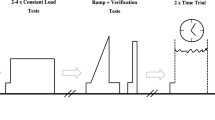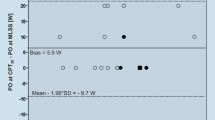Abstract
Several endurance sports, e.g. road cycling, have a varying intensity profile during competition. At present, few laboratory tests take this intensity profile into consideration. Thus, the purpose of this study was to examine the prognostic value of heart rate (HR), lactate (La−1), potassium (K+), and respiratory exchange ratio (RER) performance at an exhausting cycling exercise with varying intensity. Eight national level cyclists performed two cycle tests each on a cycle ergometer: (1) a incremental test to establish VO2max, maximum power (W max), and lactate threshold (VO2LT), and (2) a variable intensity protocol (VIP). Exercise intensity for the VIP was based upon the VO2max obtained during the incremental test. The VIP consisted of six high intense (HI) workloads at 90% of VO2max for 3 min each, interspersed by five middle intense (MI) workloads at 70% of VO2max for 6 min each. VO2 and HR were continuously measured throughout the tests. Venous blood samples were taken before, during, and after the test. Increases in HR, La-, K+, and RER were observed when workload changed from MI to HI workload (P < 0.05). Potassium and RER decreased after transition from HI to MI workloads (P < 0.05). There was a negative correlation between time to exhaustion and decrease in La- concentration during the first MI (r = −0.714; P = 0.047). Furthermore, time to exhaustion correlated with VO2LT calculated from the ramp test (r = 0.738; P = 0.037). Our results suggest that the magnitude of decrease of La−1 between the first HI workload and the consecutive MI workload could predict performance during prolonged exercise with variable intensity.





Similar content being viewed by others
References
Ahlborg B (1967) Pulse rate during prolonged exercise in man. Försvarsmedicin 3:112–120
Allen D, Westerblad H (2004) Lactic acid—The latest performance enhancing drug. Science 305:1112–1113
Bang O (1936) The lactate content of the blood during and after muscular exercise. Scand Arch Physiol 74:49–82
Basset DR Jr, Howley ET (2000) Limiting factors for maximum oxygen uptake and determinants of endurance performance. Med Sci Sports Exerc 32:70–84
Bonen A, McCullagh KJ, Putman CT, Hultman E, Jones NL, Heigenhauser GJ (1998) Short-term training increases human muscle MCT1 and femoral venous lactate in relation to muscle lactate. Am J Physiol 274:102–107
Borg G (1998) Borg’s perceived exertion and pain scales. Humankinetics, Champaign, IL, pp 1–104
Bot SD, Hollander AP (2000) The relationship between heart rate and oxygen uptake during non-steady state exercise. Ergonomics 43:1578–1592
Buchanan R, Nielsen OB, Clausen T (2002) Excitation- and β2-agonist induced activation of the Na+–K+ pump in rat soleus muscle. J Physiol 545:229–240
Costill DL (1970) Metabolic responses during distance running. J Appl Physiol 28:251–255
Coyle E (1995) Integration of the physiological factors determining endurance performance ability. Exerc Sport Sci Rev 23:25–63
Dubouchaud H, Butterfield GE, Wolfel EE, Bergman BC, Brooks GA (2000) Endurance training, expression, and physiology of LDH, MCT1, and MCT4 in human skeletal muscle. Am J Physiol 278:E571–E579
Ekelund LG, Holmgren A (1964) Circulatory and respiratory adaptation, during long-term, non-steady state exercise, in the sitting position. Acta Physiol Scand 62:240–255
Fernandez-Garcia B, Perez-Landaluce J, Rodriguez-Alonso M, Terrados N (2000) Intensity of exercise during road race pro-cycling competition. Med Sci Sports Exerc 32:1002–1006
Fitts RH (1994) Cellular mechanisms of muscle fatigue. Physiol Rev 74:49–94
Foxdal P, Sjödin B, Rudstam H, Östman C, Östman B, Hedenstierna GC (1990) Lactate concentration differences in plasma, whole blood, capillary finger blood and erythrocytes during submaximal graded exercise in humans. Eur J Appl Physiol 61:218–222
Gore J (2000) Physiological tests for elite athletes. Australian Sports Commission. Humankinetics, Champaign, IL
Green H, Halestrap A, Mockett C, O’Toole D, Grant S, Ouyang J (2002) Increases in muscle MCT are associated with reductions in lactate after a single exercise session in humans. Am J Physiol 282:E154–E160
Johnson JS, Carlson JJ, Vanderlaan RL, Langholz DE (1998) Effects of sampling interval on peak oxygen consumption in patients evaluated for heart transplantation. Chest 113:816–819
Juel C (1996) Lactate/proton co-transport in skeletal muscle: regulation and importance for pH homeostasis. Acta Physiol Scand 156:369–374
Karlsson J, Saltin B (1970) Lactate, ATP, and CP in working muscles during exhaustive exercise in man. J Appl Physiol 29: 596–602
Kristensen M, Albertsen J, Rentsch M, Juel C (2005) Lactate and force production in skeletal muscle. J Physiol 562:521–526
Kuipers H, Keizer HA, Verstappen FT, Costill DL (1985) Variability of aerobic performance in the Laboratory and its physiologic correlates. Int J Sports Med 6:336–339
Lucia A, Hoyos J, Carvajal A, Chicharro JL (1999) Heart rate response to professional road cycling: the Tour de France. Int J Sports Med 33:167–172
Maron MB, Horvath SM, Wilkerson JE, Gliner JA (1976) Oxygen uptake measurements during competitive marathon running. J Appl Physiol 40:836–838
Medbø JI, Sejersted OM (1990) Plasma potassium changes with high intensity exercise. J Physiol 421:105–122
Nielsen JJ, Mohr M, Klarskov C, Kristensen M, Krustrup P, Juel C, Bangsbo J (2004) Effects of high-intensity intermittent training on potassium kinetics and performance in human skeletal muscle. J Physiol 554:857–870
Nielsen OB, de Paoli F, Overgaard K (2001) Protective effects of Lactic acid on force production in rat skeletal muscle. J Pysiol 536:161–166
Padilla S, Mujika I, Cuesta G, Goiriena JJ (1999) Level ground and uphill cycling ability in professional road cycling. Med Sci Sports Exerc 31:878–885
Padilla S, Mujika I, Orbananos J, Santisteban J, Angulo F, Jose Goiriena J (2001) Exercise intensity and load during mass-start stage races in professional road cycling. Med Sci Sports Exerc 33:796–802
Pilegaard H, Terzis G, Halestrap A, Juel C (1999) Distribution of the lactate/H+ transporter isoforms MCT1 and MCT4 in human skeletal muscle. Am J Physiol 276:E843–E848
Ruff RL (1996) Sodium channel slow inactivation and the distribution of sodium channels on skeletal muscle fibres enable the performance properties of different skeletal muscle fibre types. Acta Physiol Scand 156:159–168
Saltin B, Stenberg J (1964) Circulatory response to prolonged severe exercise. J Appl Physiol 19: 833–838
Sjøgaard G, Adams RP, Saltin B (1985) Water and ion shifts in skeletal muscle of humans with intense dynamic knee extension. Am J Physiol 248:R190–R196
Wilson MC, Jackson VN, Heddle C, Price NT, Pilegaard H, Juel C, Bonen A, Montgomery I, Hutter OF, Halestrap AP (1998) Lactic acid efflux from white skeletal muscle is catalyzed by the monocarboxylate transporter isoform MCT3. J Biol Chem 273:15920–15926
Wingo JE, Lafrenz AJ, Ganio MS, Edwards GL, Cureton KJ (2005) Cardiovascular drift is related to reduced maximal oxygen uptake during heat stress. Med Sci Sports Exerc 37:248–255
Acknowledgements
We would like to thank all the participating subjects and also Hans-Christer Holmberg, Karolinska Institute and Marko Laaksonen, Mid-Sweden University for help in various ways. This study was supported by the National Wintersport Center in Östersund, The Swedish National Centre for Research in Sports, Sundsvalls Kommun, and Mid-Sweden University.
Author information
Authors and Affiliations
Corresponding author
Rights and permissions
About this article
Cite this article
Björklund, G., Pettersson, S. & Schagatay, E. Performance predicting factors in prolonged exhausting exercise of varying intensity . Eur J Appl Physiol 99, 423–429 (2007). https://doi.org/10.1007/s00421-006-0352-0
Accepted:
Published:
Issue Date:
DOI: https://doi.org/10.1007/s00421-006-0352-0




